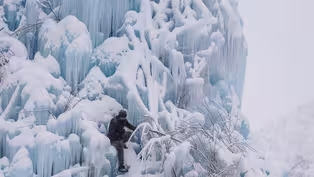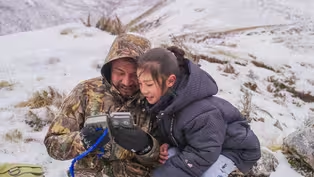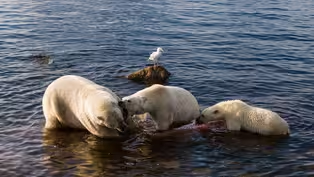
Humpback Whale Tagging
Clip: Episode 1 | 6m 28sVideo has Closed Captions
Whale researchers attach sensors to humpback whales to gather scientific information.
Whale researchers Dave Cade and Shirel Kahane-Rapport attach sensors to humpback whales to gather scientific information. It’s a tricky procedure in the challenging conditions of Antarctica.
Problems playing video? | Closed Captioning Feedback
Problems playing video? | Closed Captioning Feedback

Humpback Whale Tagging
Clip: Episode 1 | 6m 28sVideo has Closed Captions
Whale researchers Dave Cade and Shirel Kahane-Rapport attach sensors to humpback whales to gather scientific information. It’s a tricky procedure in the challenging conditions of Antarctica.
Problems playing video? | Closed Captioning Feedback
How to Watch Dynamic Planet
Dynamic Planet is available to stream on pbs.org and the free PBS App, available on iPhone, Apple TV, Android TV, Android smartphones, Amazon Fire TV, Amazon Fire Tablet, Roku, Samsung Smart TV, and Vizio.
Buy Now
Providing Support for PBS.org
Learn Moreabout PBS online sponsorship[dramatic music] ♪ ♪ - The West Antarctic Peninsula, it's an indicator place, where things that are going to happen in the rest of Antarctica are happening here first.
It's the place where you can kind of feel that existential dread.
[ice cracking] We're sitting here in this bay, and you can hear glaciers calving in a way that used to be a really rare unique event.
[ice cracking] ♪ ♪ - The peninsula is already five degrees Fahrenheit warmer than it was in the 1950s.
And the sea is free of ice for three months longer.
- More ice-free days give whales more days to feed before the ice freezes over.
But young krill need ice to survive.
So, in the long term, less ice is going to mean less krill, which is gonna support fewer whales.
♪ ♪ We're out here studying humpback whales to understand how they are changing their behavior in response to changing conditions.
♪ ♪ - We're studying them using biopsies and using tag data, and that data will give us an idea about what the whales are foraging on, where, and when.
These tags are pretty smart.
They are full of sensors.
They have a camera in them.
They have a radio so that we can find them.
I mean, this thing basically can tell us everything that the whale is doing and film it for us at the same time.
- It's getting them on the whales that's the hard part.
♪ ♪ - It's a light carbon-fiber pole, but once you put a four-pound tag at the end of it, it all of a sudden is, like, pretty unwieldy and hard to use.
You sneak up on them.
Your adrenaline's going.
Your hands are cold.
You can barely see.
You're trying to yell at the driver.
Whoa.
No, no, no, no, no.
I think I see some whales.
A little closer, a little closer, a little closer, a little closer.
That's close enough.
Oh, right on.
Got it.
- We also have a special biopsy dart on a crossbow.
We shoot that at the whale's back.
And it doesn't make the whale bleed.
Often, they don't even notice that we've taken a biopsy.
And we can use that to understand pregnancy, health levels, and sex.
And so he sticks the tag on.
I shoot the dart.
The GoPro on my head is running.
The GoPro on Dave's chest is running.
All of that's happening at the same time.
Tag on, biopsy taken, the whale swims off.
And then we get on to the next one.
Ah, crap.
- You're fine.
- It's still there.
- Go forward, Ryan.
Forward, forward, go, go, go.
Very nice.
Good sample.
- One of the things I love is seeing these whales up close.
It's a huge privilege.
Not a lot of people get to do that.
Oh.
Oh, my God.
Hi, Claudia.
Her name is totally Claudia.
She came over when I said "Claudia."
Oh, my God.
Hi.
♪ ♪ Oh, my goodness.
I looked in a whale's eyeball, which is not something everybody can say, and it was a pretty magical moment.
And you can see that that whale, that it knows that you're there.
She is 100% looking at us.
- When you see that whole animal underwater coming up next to your boat, you realize, this is an animal that's bigger than your boat and has a lot of power and a lot of control.
- That was a bump.
So... shall we go for a dart?
- Yeah, go ahead.
♪ ♪ - Oh, my goodness.
Oh, my goodness.
♪ ♪ Okay, I'm going to remove this arrow from the thing because it's starting to freak me out.
She's too close for me to shoot.
♪ ♪ - Oh, man.
Watch out.
- Claudia, what are you doing?
She was telling us that the tag is off.
That's what just happened.
Look.
- That's it.
- You goony.
- They won't be getting any data from Claudia today.
And with the snow setting in, it's time to return to the warmth of the yacht to examine the successful tags.
- Almost 2 1/2 minutes just to get down to the first lunge.
- Yeah, and not even at 400 meters, or is this one at-- - Yeah, 400 meters, yeah.
- So, just after we tagged it, it just went back to 400 meters?
- Pah-shh!
It dove.
- Oh.
That's amazing.
- Nose dive, yeah.
- That's amazing.
- The tags we've seen so far are awesome, 'cause these whales are switching between going down to 400 meters depth and then being up at the surface.
So these humpback whales are very adaptable, and they're trying to adapt to this kind of rapidly changing environment by using new strategies every year.
- The big question is how the whales will cope if we keep losing sea ice and krill numbers decline.
- Humpback whales will likely adapt because they do have that capability.
But they may stop going to the Antarctic if there's not food for them there.
- Scientists say that all of Antarctica, not just the peninsula, is starting to feel the heat.
But the continent is so immense that we still have time to act and limit the damage.
♪ ♪
Video has Closed Captions
Clip: Ep1 | 2m 42s | Mountain guides venture into a glacier high in the mountains to examine how fast it is melting. (2m 42s)
Video has Closed Captions
Preview: Ep1 | 30s | Explore how science, nature, and tradition prepare us for the future as ice melts across the poles. (30s)
Video has Closed Captions
Clip: Ep1 | 6m 44s | Witness the unique behavior of polar bears hunting beluga whales in Canada. (6m 44s)
Providing Support for PBS.org
Learn Moreabout PBS online sponsorship
- Science and Nature

Explore scientific discoveries on television's most acclaimed science documentary series.

- Science and Nature

Capturing the splendor of the natural world, from the African plains to the Antarctic ice.












Support for PBS provided by:


